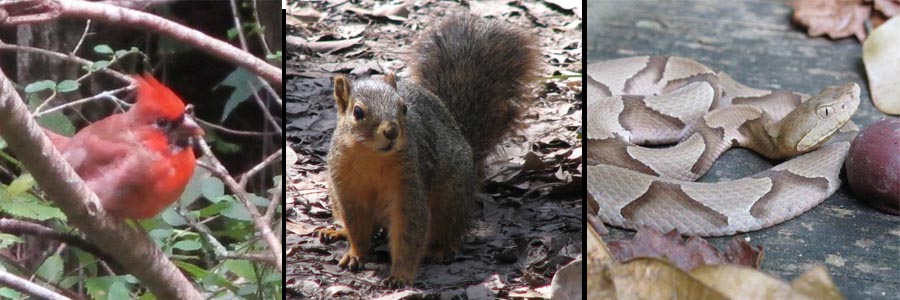Birds Mammals Reptiles Amphibians Butterflies Insects Spiders

Animals thickly populate the forested areas of the park during all seasons of the year. The lushness of vegetation supports equally dense communities of insects and other invertebrates, thus setting the stage for a diverse group of predators. During the warm months,
frogs,
snakes, and lizards can be observed throughout every layer of the forest.
 Visitors should exercise reasonable caution on trails by not walking, sitting, or reaching toward the ground without first looking. Although we have not had the misfortune of experiencing a single snakebite in our 40-year history, please be aware that poisonous snakes such as the cottonmouth moccasin and the copperhead do live here.
Visitors should exercise reasonable caution on trails by not walking, sitting, or reaching toward the ground without first looking. Although we have not had the misfortune of experiencing a single snakebite in our 40-year history, please be aware that poisonous snakes such as the cottonmouth moccasin and the copperhead do live here.
Over 150 species of
birds have been recorded by the park’s dedicated group of birders. Nesting species include Mississippi Kite, Broad-winged Hawk, Red-shouldered Hawk, Pileated Woodpecker, Ruby-throated Hummingbird, Acadian Flycatcher, White-eyed Vireo, and Swainson’s and Hooded Warblers. Winterers include Yellow-bellied Sapsucker, Orange-crowned, Pine and Yellow-rumped Warblers, Solitary Vireo, and Cedar Waxwing. During spring migration, rainy weather in the park or further south along the coast may ground large numbers of migrants and produce high concentrations of songbirds, especially warblers. Fall migration is more spread out, with the earliest migrants passing through in early July and the latest in December. With the arrival of autumn cold fronts large numbers of migrants, including waterfowl and birds of prey, can be seen in the skies above the park from the high ground near Alexander Street. From the same vantage point during spring and summer, large numbers of ibis, egrets, and herons can be seen flying over the park in the mornings and evenings as they travel between their feeding grounds and their rookery at Lake Martin, to the southeast.
The much sought-after Swainson’s Warbler can be found in a few locations in the park. Although its loud, beautiful song can be plainly heard from April through mid-summer, catching a glimpse of the bird can be much more difficult. The best locations to look for it are on the trails across François Coulee, especially on the trails to the right of the bridge.
The majority of mammals that live here are rarely seen during the nature trail’s regular visiting hours, as they are nocturnal. Our monthly night hike participants, however, have seen armadillo, flying squirrel, raccoon, opossum and skunk. Other resident mammals include fox squirrel, bobcat, short-tailed shrew, eastern mole, and eastern wood rat.
Although copperhead and cottonmouth should be watched for, there are more than a dozen non-venomous species present in the woods. All snakes are of course protected here. Other reptiles include five species of lizard, Red-eared Turtles which can be seen swimming in François Coulee throughout the year, and uncommonly, Painted and Common Snapping Turtles. Gulf Coast Box Turtles were probably once numerous in the park, but probably suffered from human activity.
The diversity of habitats found within the park is reflected in the wide variety of insects which inhabit it. Among the more eye-catching are the large silkworm moths, including the beautiful pale-green luna moth which is prominent during the summer. Large beetles, such as the patent leather beetle, can be found near decaying logs. And, of course, there are usually a few mosquitos throughout the year.
We reached the old wolf in time to watch a fierce green fire dying in her eyes. I realized then, and have known ever since, that there was something new to me in those eyes — something known only to her and to the mountain. I was young then, and full of trigger-itch; I thought that because fewer wolves meant more deer, that no wolves would mean hunters’ paradise. But after seeing the green fire die, I sensed that neither the wolf nor the mountain agreed with such a view. — Aldo Leopold